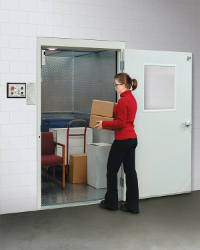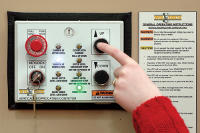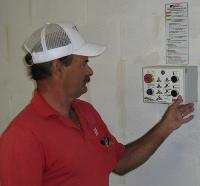Owners and developers looking to build or upgrade self-storage facilities are deluged with details, decisions, permits and many other concerns. To be successful they are rethinking their operation and overall facility design, and looking for a competitive edge that will attract new rental tenants. One solution that is becoming more attractive is to expand first-floor units for recreational vehicle storage for items such as boats, trailers, motor homes, collector cars, golf carts, and all-terrain vehicles. With larger main level units providing increased revenue, a second level can be added to a portion of these facilities to provide safe and convenient access to smaller, more affordable rental units.

Adding a second level can be cost effective since it utilizes existing real estate and can also offer the increased security that comes from key-controlled access. Many facility owners, however, cringe at the thought of moving up because of all the hassles and costs associated with an elevator installation. Vertical Reciprocating Conveyors (VRCs), on the other hand, are a much better option.
Lower-Cost Alternative
For many years, suppliers like Waukesha, WI-based Wildeck have been designing and building customized self-storage VRCs for a variety of applications. These freight-only or material lifts offer a lower cost alternative to elevators for easy access to a second level. The total cost of VRC ownership can be up to three times less than an elevator and can be installed in a fraction of the time. Since people cannot ride on a material-only lift, the VRC becomes a safer and more cost-effective solution for transferring a tenant’s belongings to the second floor where rental rates are typically less than ground-level units. Today’s VRC controls also make operation virtually foolproof with intuitive, easy-to-read lift status lights and built-in safety features.
There are a number of things to consider when comparing the two.

Tenants typically arrive at a facility to carry boxes or bulky items to their unit. Moving their materials to a second-level 10 ft by 10 ft, or 10 ft by 20 ft rental unit is straightforward. After checking in at the front desk and acquiring a safety key, they can unlock the VRC operator control, which on Wildeck’s EZ Pro™ Operator Station has a bright green LED light that glows when the lift is “ready-to-load.” Wildeck’s ArmorCar™ VRC cab or carriage interior is lighted and fully enclosed with rugged diamond-plate wall and floor panels.
The interior is virtually maintenance free and once loaded, a roll-up gate safely secures the tenant’s belongings. The hinged outer door is then closed, signaling the user that it is safe to send the loaded VRC up to the second level. The tenant can then unlock the stairwell access door and go up one flight to meet the VRC for unloading. When two users are involved, the second individual may already be stationed on the second level and can push the ‘up’ button to call the VRC. The person on the lower level can also ‘send’ the VRC up.
Case Study: AAA American Storage
A VRC typically has a larger capacity than an elevator, which means that more material can be moved at one time. Using a VRC to transfer material greatly reduces the chance of injury from falling boxes. When safety, efficiency, and cost are compared, installing a VRC instead of an elevator can show up quickly on your bottom line. Just ask Jim Gearhart, owner of AAA American Storage in Groveland Fla.
“Adding a VRC that is both functional and looks good was very important,” he said. “It gives our newly expanded facility a competitive edge and costs a lot less than a large elevator. It is also secure and well lit, which customers like.”
Gearhart’s 87,000 sq ft, multi-level self-storage facility, completed in November 2006, is one of the largest self-storage operations in Florida. It boasts some of the latest innovations and equipment available today for safe, secure, and efficient material handling and storage.With people either on the move or just settling in, the area needed an up-to-date self-storage facility that could provide both a temporary and long-term secure storage for their personal property. After site research and discussions with local community officials, Gearhart selected a location just off the main thoroughfare that connects Groveland with surrounding communities. Gearhart had previously been involved with building several other self-storage facilities with 600 to 700 rental units each, and this experience was instrumental in helping his plans for Groveland move forward.
Finding the Right Supplier
“Partnering with experienced suppliers was essential because it allowed us to achieve the quality and state-of-the-art facility that we needed to attract tenants,” Gearhart said.
AAA American Storage selected U.S. Door & Building Components of Orlando for self-storage facility construction and purchased a new Wildeck VRC material lift from AME Vertical in Troy, MI.
Initial work on the Groveland facility began in June of 2000 with site preparation and construction of three buildings, including offices and on-site living quarters for Gearhart. Work soon proceeded on 200 rental units around the perimeter of the site. Rentals of these standard units moved quickly, so plans were finalized to build additional units and to build up, not out. The addition of 400 new rental units in the center area of the facility included a second level with 200 units served by a handicap-accessible elevator, two stairways and a 2,000 lb capacity Wildeck VRC with a 6 ft wide by 8 ft long by 7 ft high carriage.
During construction of the final center section, which was completed in November 2006, AAA American Storage installed the VRC lift first and used it to move building materials up to complete the new second level.
“The VRC worked great and saved us a considerable amount of money on crane rental,” Gearhart said. “I would certainly recommend it to anyone looking to add a second level.”
Attracting new tenants also meant offering deluxe, climate-controlled rental units, which are in demand throughout Florida due to the warm climate. Units in the interior of the lower center section are ideally suited for climate control since they are more insulated from the sun’s rays and therefore less expensive to cool.
“We have three buildings that are now air-conditioned and the largest units are 10 ft by 45 ft,” Gearhart said. “They can store rooms of furniture, cars, and even a nice fishing boat.”
The self-storage industry continues to provide opportunities for entrepreneurs like Gearhart to expand, and as he proved, moving up was easier than you may think. There are about 10,000 facilities in the United States today and Florida ranks third behind Texas and California with the most establishments.
“I enjoy the business and am satisfied that we are providing an essential service for families and companies who are looking for safe and secure storage,” Gearhart said.
Comparison Chart: VRC vs Elevator






